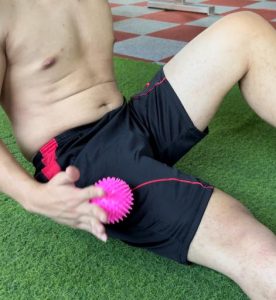Relieving Leg Muscle Pain and Soreness: Embracing the Power of Spiky Balls and Foam Rollers

Relieving Leg Muscle Pain and Soreness: Embracing the Power of Spiky Balls and Foam Rollers
Our legs carry us through countless adventures, but sometimes they remind us of their hard work with muscle pain and soreness. Whether you’re an athlete, a fitness enthusiast, or simply active in your daily life, leg muscle pain is a common hurdle. The good news is that there are techniques available to help you find relief and get back on your feet. In this article, we’ll explore the fascinating world of spiky balls and foam rollers, and how they can become your allies in the battle against leg pain.
Understanding Leg Muscle Pain and Soreness:

When you push your body to new limits or engage in intense physical activities, your leg muscles may experience delayed onset muscle soreness (DOMS). DOMS occurs due to microscopic damage to the muscle fibers, resulting in inflammation and discomfort. It typically emerges within 24 to 72 hours after exercise, making even simple tasks a challenge.

The Power of Spiky Balls:

Imagine having a little friend with tiny spikes to massage your leg muscles and bring relief. Spiky balls, also known as massage balls or lacrosse balls, have become popular tools for promoting muscle recovery and alleviating pain. These little warriors stimulate blood circulation and provide targeted pressure. Here’s how you can use spiky balls to ease your leg muscle pain:
- Foot Roll: Sit comfortably on a chair, take off your shoes, and place the spiky ball under your foot. Roll your foot back and forth over the ball, applying just the right amount of pressure. As you do this, pay attention to any tender spots or tight areas. Give them a little extra love by pausing on them for a few seconds. Repeat this process on both feet, spending a few minutes pampering your hardworking soles.

- Glute Release: Find a cozy spot on the floor or a mat and position the spiky ball under one buttock. Gently roll your gluteal muscles over the ball, adjusting the pressure to your liking. Explore the area for any tight or sore spots, and when you find them, let the spiky ball work its magic. Pause on those areas, allowing the spikes to release the tension. Repeat on the other side, ensuring each cheek receives its well-deserved attention.

Using Foam Rollers for Leg Pain Relief:

Foam rollers, like fluffy companions, provide a different approach to leg pain relief. These cylindrical tools made of dense foam help release tension and improve flexibility by applying pressure to trigger points and tight muscles. Let’s dive into some techniques that can help you embrace the benefits of foam rolling:
Quadriceps Roll: Lie face down on the floor with the foam roller positioned beneath your thighs. Use your forearms to support your weight and begin rolling forward and backward, from your hips to just above your knees. Pay attention to those areas that whisper stories of tightness or tenderness. Give them some extra care by pausing on them, allowing the foam roller to ease the tension. Keep rolling for a few minutes, making sure both legs receive equal love.

- Calf Roll: Find a comfortable spot on the floor and extend your legs. Place the foam roller beneath your calves and position your hands slightly behind you for support. Begin rolling the foam roller up and down your calves, targeting any areas that feel uncomfortable or tight. As you do this, adjust the pressure to suit your needs, and spend some extra time on those spots that require a little more attention. Repeat this process for a few minutes on both legs, making your calves feel pampered.

Conclusion:
Our legs deserve the best care, especially when they speak to us through pain and soreness. By embracing the power of spiky balls and foam rollers, you can offer them the relief they need. Incorporating these techniques into your post-workout or recovery routine can enhance muscle recovery, improve flexibility, and help you get back to your active lifestyle faster. Remember to listen to your body, adjust the pressure and duration of these exercises based on your individual needs, and consult a healthcare professional if you have any underlying medical conditions or concerns. Let your leg muscles feel the love and support they deserve on your journey to pain-free movement.
Disclaimer: This article is intended for informational purposes only and should not replace professional medical advice. If you have pre-existing medical conditions or are unsure about incorporating these techniques into your routine, consult with a healthcare professional before proceeding.

